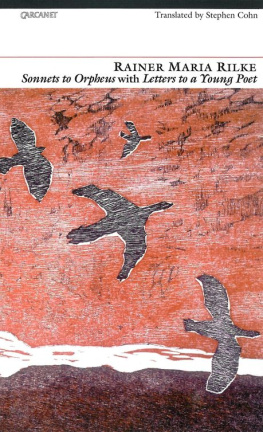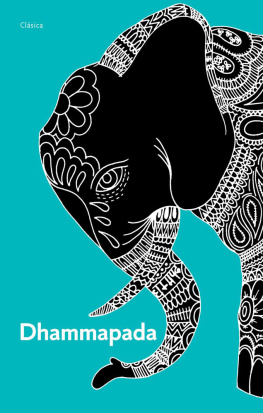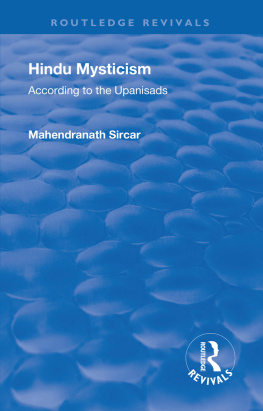I wish once more to thank Peter Porter and Ray Ockenden who generously gave their time and their talent in working on the Sonnets.
Beau ciel, vrai ciel, regarde-moi qui change!
Aprs tant dorgueil, aprs tant dtrange
Oisivet, mais pleine de pouvoir,
Je mabandonne ce brillant espace,
Sur les maisons des morts mon ombre passe
Qui mapprivoise son frle mouvoir.
Paul Valry, Le Cimetire marin
I find an infinite grace in the fact, wrote Rilke to his Polish translator Witold Hulewicz, that I was permitted to fill both these sails with the same breath: the small rust-coloured sail of the Sonnets as well as the huge white canvas of the Elegies.
The year 1922 saw the publication of Eliots The Waste Land, James Joyces Ulysses (500 copies were incinerated by the US Post Office), Paul Valrys Charmes and Edith Sitwells Faade. It was also Rilkes own great year, in which the Duino Elegies and the Sonnets to Orpheus were both completed. They were published in the following year.
He had begun his work on the Elegies in 1912, at Castle Duino on the Adriatic. Over the years Rilke came more and more to regard them as his lifes-project, his Auftrag or commission. Between 1912 and 1915 and at various locations he worked on poems in the projected cycle; at Duino itself, at Ronda in the south of Spain, in Paris, and lastly in Munich during the First World War. From this time on his work on the Elegies virtually came to a halt and even Rilke sometimes doubted if he would succeed in completing them. The July of 1921, an exceptionally scorching summer, saw the poet for the first time installed in the primitive Chteau de Muzot, near Sierre in the Swiss Valais. It was the year in which Rilke had come face to face with the verse of Paul Valry and had made a translation of Le Cimetire marin. His encounter with the French Symbolist signalled a new beginning: one day I read Valry and I knew that my waiting was over.
Leased for him through the kindness of a benefactor, Werner Reinhart, the little Chteau de Muzot was perhaps the closest that the poet had ever come to having a home of his own. Dating from the thirteenth century, it is in feeling and scale more a tall manor-farmhouse than what anyone might expect of a chteau a tower of great character, dark in tone and with a stepped gable. Here at Muzot during an explosion of inspired and frenzied creative activity, Rilke succeeded in completing the great structure of the Duino Elegies.
He was also, to his own surprise, given the two parts of the Sonnets to Orpheus. They are, wrote Rilke later, perhaps most mysterious, even to me, in the manner in which they arrived and imposed themselves on me the most puzzling dictation I have ever received and taken down. The whole of the first part was transcribed by me in one single breathless act of obedience with not one single word in doubt or needing to be changed.
The Sonnets of Part 1 were written between 2 and 5 February 1922: twenty-five poems, one of which was later replaced by 1: XXI, the little Kinderfrhlingslied. A twenty-sixth poem, the present 1: XXIII, was later added to Part 1. Between 15 and 23 February Rilke completed the twenty-nine poems of Part 2. The same month of February saw not only the genesis of the Sonnets and the completion of the Elegies, but also the arrival of a further twenty-five poems which seem, as one would expect, to belong to the family of the Sonnets. During the same period Rilke found time to write the Brief des jungen Arbeiters (the highly controversial Worker Letter) and also some substantial private letters, including three to Lou Andreas-Salom.
The return to his work on the Elegies had meant that, initially at least, Rilke had had to retrace his steps and to undertake a kind of day-dream journey to the point in his past life at which that work had been abandoned. The image of the traveller pausing and turning to scan the landscape which has already been left far behind him occurs arrestingly in the Eighth Elegy. But here in the Sonnets there is preponderantly the sense of something different at work, the feeling that we are hearing the voice of a Rilke who suddenly finds himself, perhaps to his own surprise, standing in the very centre of his own and the worlds living present and gazing around him; sometimes in dismay but also often in delight at being himself alive and living in that present, in that world. The Sonnets possess a special openness and lightness, a wind blows through them and their air is fresh to breathe. In the Neue Gedichte, too, the young Rilke under the example of Rodin had started to look at the things, animals and people in the world outside himself with a new freshness, a new surprise, and to make poetry from his looking: an immensely introverted young artist who had at last learned the trick of looking out from the self. In the Sonnets something similar is happening: Rilke seems again to succeed, this time in a slightly different way, in escaping from and transcending the closed box of self. It is as if the Singing God had handed him a key.
Both the Elegies and the Sonnets are difficult poetry, though they are not impenetrably so. Rilkes Neue Gedichte seem incomparably more accessible but there is no reason why we should not value one kind of poetry for its clarity and another, equally, for its mysteries. In the final year of his life, Rilke wrote to his publisher Anton Kippenberg asking to be sent copies of the Elegies and the Sonnets interleaved with plain paper, so that he could work on an interlinear text to the Sonnets in particular for his own use and for the use of certain of his friends. Rilke came only gradually to understand the difficulties presented by the Sonnets and to realise that there are lines in them that are almost incomprehensible without the help of some exegesis. And yet Rilkes own discursive commentaries can make the poetry seem even more hermetic than before often his explanations are like prose-poems in their own right, and difficult prose-poems at that.
It is best to stay cautious in explaining Rilke. In his first letter of 1903 to Franz Xaver Kappus, the officer-cadet young poet, the twenty-seven-year-old Rilke wrote to his nineteen-year-old disciple: there is nothing which touches works of art so little as does the language of criticismFew things are in fact as accessible to reason or to language as people will generally try to make us believe. Most phenomena are unsayable, and have their being in a dimension which no word has ever entered; and works of art are the most unsayable of all they are mysterious presences whose lives endure alongside our own perishable lives In a later letter he returned to this theme: Works of art are infinitely solitary, and nothing comes so little near them as does criticism. It is love alone that can grasp them and hold them and do them justice.
Having entered Rilkes caveat, I shall nevertheless again grasp the nettle. Rilkes Sonnets are built around the Orpheus legend already taken up by him in the magnificent Orpheus. Eurydike. Hermes of the Neue Gedichte. The story of Orpheus is perhaps based on the life of an actual historical figure, that of a Thracian follower of the cult of Dionysus. According to the legend he married Eurydice, a Dryad or tree-nymph, who was later bitten by a serpent and died. Orpheus valiantly descended to the Underworld to intercede for her return to the land of the living, and by his music so charmed Pluto and Persephone, the guardians of Hades, that they were persuaded to release her. But a condition was imposed that Orpheus should not look at his wife during the journey from Hades back to the world above. Orpheus, momentarily forgetting the prohibition, turned during the journey and looked at Eurydice. Thereupon Eurydice was banished forever to the Underworld; eternally lost to Orpheus by a moments inattention on his part.









